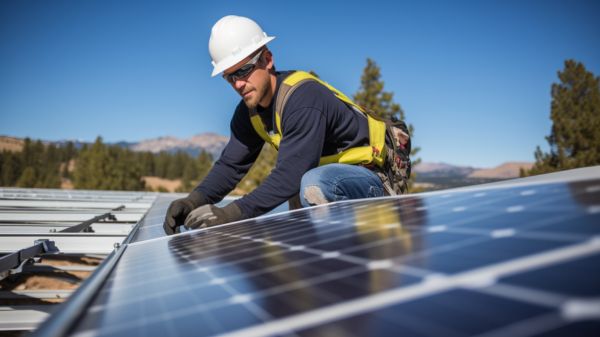DIY Home Solar Panel Guide: 3 Top-Tier Expert Tips
In the world of DIY home solar panel installation, the right guide is key to ensuring a successful and efficient project. The three top-tier guides in this article bring forth a wealth of knowledge and expertise to assist homeowners in steering through the intricacies of solar power integration.
Whether you are a novice or a seasoned DIY enthusiast, these guides offer a structured approach and expert advice on harnessing solar energy for your home. Stay tuned to discover the indispensable insights and practical tips these guides have to offer for starting on your solar panel journey.
Key Takeaways
- Consider home type, energy needs, and independence level for optimal solar panel kit selection.
- Tailoring the system to specific requirements is crucial for DIY solar panel installation success.
- DIY solar panel kit costs range from $575 to $1,350, with professional installation constituting approximately 10%.
- DIY route may miss out on solar incentives and rebates available with professional installation.
- Carefully weigh DIY cost savings against potential benefits and long-term sustainability goals.
Solar Panel Kit Components
When assembling a DIY home solar panel system, the right guide to solar panel kit components play a vital role in ensuring the system’s functionality and efficiency. Key components like solar panels, battery banks, power inverters, charge controllers, cables, and mounting hardware are essential for creating a reliable solar panel system for residential or off-grid use.
Solar panels are the heart of the system, converting sunlight into DC electricity. The battery bank acts as a storage unit for excess energy generated by the solar panels, ensuring a continuous power supply even when sunlight is unavailable.
Power inverters play an essential role in converting DC electricity into usable AC electricity for household appliances. Charge controllers regulate the charging of the battery bank, extending its lifespan.
Cables and mounting hardware are vital for connecting all components properly and securely mounting the solar panels for best sunlight exposure.
When all these components work together seamlessly, they form a functional and efficient solar panel system, providing sustainable power for residential or off-grid applications.
Solar Panel Kit Types
Differentiating among various solar panel kit types is crucial to tailor the system to specific energy requirements and environmental conditions.
Solar panel kits come in different types to suit varying needs, including grid-tied kits, off-grid kits, and RV kits. Grid-tied kits enable homeowners to connect their solar panels to the utility grid, allowing for energy storage or even selling excess power back to the grid.
On the other hand, off-grid kits provide independence from the utility grid by incorporating high-capacity battery banks to store energy for later use. RV kits, specifically designed for recreational vehicles, offer a smaller-scale off-grid solution for those on the move.
When selecting a solar panel kit type, factors such as home type, energy needs, and the desired level of independence should be considered to make sure the system meets specific requirements efficiently.
Solar Panel Kit Costs
Understanding the financial aspects of solar panel kits is crucial for individuals looking to invest in sustainable energy solutions for their homes.
DIY solar panel kit costs vary depending on the system size, ranging from $575 to $1,350. It’s important to mention that professional installation typically constitutes around 10% of the total cost.
While choosing the DIY route may seem like a money-saving measure, the savings compared to professional installation may be minimal. Additionally, individuals going the DIY route may miss out on certain solar incentives and rebates.
These financial incentives are often tailored towards larger systems and those that are professionally installed. Hence, before starting the solar panel installation journey, it’s vital to weigh the costs and benefits carefully to make an informed decision that aligns with both your budget and long-term sustainability goals.
Conclusion
To sum up, these three essential aspects of the right DIY home solar panel guide provide valuable information and guidance for individuals looking to install their own solar power system.
By following the step-by-step instructions and practical tips outlined in these guides, homeowners can successfully select components, design the system, and install solar panels at home.
With the help of these resources, individuals can harness the power of the sun to generate clean and renewable energy for their households.

